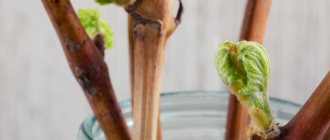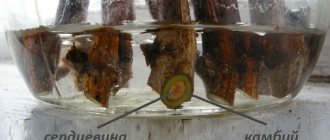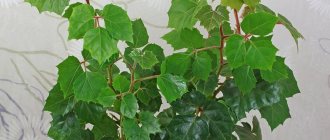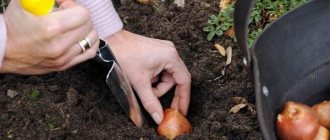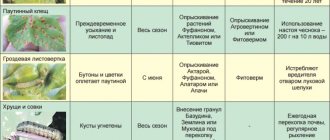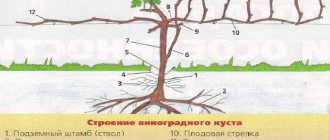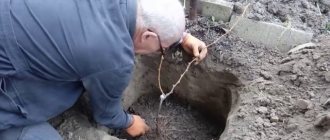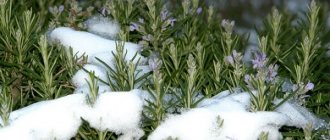Why do you need to cut the cuttings in the fall?
Among people who have no experience in growing grapes, there is an opinion that it is easier to propagate them in the spring. The main argument is that there is no need to fear that the cutting will dry out or rot over the winter (which very often happens when growing grapes). In fact, with this approach, you can waste time: a chubuk cut in the spring and planted in poorly warmed soil will most likely dry out without having time to take root. Another disadvantage in this situation is that a fresh wound will remain on the “revived” vine, and the plant will “sick” for a long time. Thus, it is more rational to store grape cuttings in winter.
How to choose suitable material for propagation?
The chubuk is cut from the middle or lower part of a fruit-bearing (this is a prerequisite) healthy one-year-old vine, which is first checked for maturity. The easiest way is to try to bend the branch a little: if it has reached the required level of development, a slight cracking sound will be heard. Additionally, you can lubricate the cut area with iodine solution: in a mature vine it will turn black. Very thin or thick shoots are not suitable for seedlings, as they will not produce high-quality planting material.
How to properly prepare future seedlings?
The main question that experienced winegrowers are asked about grape cuttings is: “How do you store planting material during the long winter in order to get healthy shoots in the spring?”
There are a few things to consider here. It is best to harvest the chibouk in late September or early October (adjustments are made depending on the weather). At this time, the vital activity of the plants decreases, and pruning will cause less harm to the grapes. Since branches preparing for winter lose most of their moisture, it is necessary to partially replenish its reserves before storage. This is done quite simply: all the leaves and tendrils are removed from the cut cuttings, a fresh cut is made in its lower part, and the stem itself is placed in water (preferably rain or melted water, but always clean) for about a day. This procedure will protect the twig from drying out, and it will safely survive the winter. You can additionally dip the sections on both sides in warm paraffin - this will prevent the rapid evaporation of moisture from the trunk.
Someone additionally makes several light longitudinal grooves up to 3 cm long on the bottom of the chibouks to ensure additional development of roots in the spring.
It is recommended to moisten the prepared cuttings in iron sulfate (a few seconds is enough), and if it is not available, in a slightly colored solution of potassium permanganate, quinozol or foundationazole, then dry well. This treatment will help fight mold and various diseases.
Factors affecting the safety of the vine
To ensure safety, such aspects as proper cutting and the creation of an optimal microclimate during wintering are taken into account.
Harvesting cuttings
Cutting is carried out in the fall, when the leaves have fallen, 10-15 days after the first frost at night. The plant at this moment has a maximum concentration of nutrients and well-ripened shoots.
- For harvesting, a fruiting vine with a diameter of 7-9 mm (some articles recommend a diameter of 10-12 mm , but they take root worse). The current year's root shoots are poorly stored.
- It is better to cut in dry weather (4 days after rain).
- The length of the cuttings can range from 30 cm (minimum) to 60 cm . Only the middle part of the shoots is used, since the upper part does not have time to ripen.
- Chubuki are harvested from healthy bushes; they must be even (twisted ones take root worse).
- When bent, the ripened vine crackles, but does not break.
- The cut, made at a distance of 4 cm from the internode, must have a green color; the whiskers are removed.
You can check suitability for cuttings by immersing the cut end in a 1% solution of potassium permanganate for 1.5 minutes . If the cut remains light, it is better to discard the branch, because the darker it is, the more nutrients the plant has accumulated.
Necessary microclimate
For good survival, prepared cuttings need to create suitable conditions until spring.
- Cut vines should be stored for storage on the day of harvesting, since, depending on the temperature, they lose 2% moisture per day .
- The optimal temperature is considered to be about +0.4 degrees , but in domestic conditions they try to ensure a temperature within 0-4°C , which guarantees the preservation of a sufficiently high percentage of material suitable for rooting.
- Moisture loss should not be allowed to exceed 20% of the available supply, so it is better to ensure air humidity of at least 90%; at a lower level, the workpieces may dry out.
We must not forget that approaching the temperature to 10 degrees will cause the appearance of callus . This indicates the beginning of the root formation process. When roots appear, it is better to plant such specimens in separate containers without waiting for spring.
Storing grape cuttings in winter
When planting chibuks in the fall, several conditions must be observed that will allow you to obtain strong shoots in the spring, ready for rooting and growth.
It is very important to create the necessary thermal conditions for the cuttings: not lower than 0 degrees and not higher than +4. If the temperature drops to negative, it can freeze, and if the temperature is higher, the buds will begin to swell and the roots will grow. Or the cutting will become moldy and simply rot.
The next important point is to ensure the necessary humidity (the optimal option is 60%) so that the chibouk does not dry out, and regularly ventilate the room.
If the cuttings are stored in the basement, they become a threat to rodents, for whom they will turn into excellent food.
Where can you keep chibouks?
There are three ways to preserve grape cuttings in winter. At home, this is a refrigerator, a trench, a basement. The choice of location depends on the amount of material. Several cuttings can be placed in the refrigerator, but when preparing them for sale or for planting over a large area, the second option will be more successful. The storage method affects the characteristics of caring for cuttings during the winter.
For several seedlings, ordinary plastic bottles without a bottom with a volume of one and a half liters are also suitable. A little sand is poured into the first and two cuttings are installed, the second plays the role of a lid: to make it easier to put on, small cuts are made on the walls. The cork on the bottle cap is periodically opened to ventilate the pipes.
Procurement period
It is harmful to injure the plant once again, so we combine the preparation of cuttings with the pruning procedure.
The best time for cuttings is autumn, for which there are reasons. In summer, the shoots actively grow, life-giving juices flow through the wood, which does not allow cuttings cut at this time to be stored for a long time. During winter frosts, most of the buds either die or become inactive, and when the weather warms up, such cuttings are not able to give life to new bushes. Therefore, it is also useless to prepare material in the spring. In the autumn, on the contrary, the plant naturally prepares for winter sleep and easily survives pruning and subsequent storage of cuttings. Read about growing grapes from cuttings at home in this material. It is important to focus on the weather conditions of your region. Cuttings should be harvested before the first frost, otherwise productivity and viability are smooth and the buds drop.
How to choose the right vine for cuttings
Experienced winegrowers can determine the required vine by tactile sensations. For beginners, the correct indicator will be the appearance of the plant. The main thing is to choose a bush that bears fruit well during the season and is not susceptible to diseases. Do not confuse the varieties you are interested in. In addition to health, the age of the vine is important. It must be ripe, on a fully formed bush. You can determine the desired vine based on the following characteristics:
- Color . Shoots for harvesting should be brown, young green branches are not suitable;
- Thickness , cutting diameter should be at least 6-8 mm (with the exception of varieties with thin vines, do not forget about the specific characteristics of different bushes);
- Reaction to iodine . Take a cut of the shoot and drop some iodine on the damp part of the wood. In mature shoots, the cut will be painted with dark purple or even black paint, and in unripe shoots it will be green or yellowish.
It is desirable that the bush from which the cuttings are taken actively bears fruit for 2-3 years.
How to take cuttings
Once a vine has been selected, it is important to select the correct part to harvest. The tops are not suitable for shanks, since most often they contain immature shoots. The middle part of the vine is most preferred. Choose a straight fruit-bearing shoot, the length of which is at least 70-80 cm. The selected part must have at least 4-6 internodes and healthy buds. Pruning cuttings is subject to the following rules:
- the selected tool (secateurs or cutter) must be sharp , well sharpened and preferably disinfected;
- the length of the blanks is 50-70 cm, so that in the spring before planting there is an opportunity to select the healthiest living part;
- the lower cut is made at an acute angle to the direction of growth, and the upper one passes through the middle of the internode;
- the more buds and eyes there are on the chibouk, the better;
- tendrils, leaves, stepsons and excess bark are removed from the planting material.
Cold storage
It is better to use the chamber for vegetables and fruits, since there the temperature is most favorable for the chibouk. In its absence, you can ensure winter storage of cuttings (in small quantities, of course) on the bottom shelf of the refrigerator. To establish the required level of humidity, experienced people advise wrapping the lower part of the pipes with a cloth soaked in water and wrung out, then placing them in a plastic bag and tying them well with a rope. The only caveat is that you should not wrap the seedling completely, as this will lead to its rotting. Next, all that remains is to check the condition of the cuttings monthly and, if necessary, treat them: wipe the area where mold appears with a cotton swab soaked in a pink solution of potassium permanganate. Before placing the chibouk back in the refrigerator, it will need to be dried.
Other ways to save cuttings until spring
Not every vineyard owner knows how to ensure wintering in a cellar in the sand. To do this, make a partition near the cellar wall and fill the resulting niche with sand. Afterwards, stick the prepared stems into the sand and leave them until spring, and for the convenience of separating varieties, separate groups of seedlings with a board or other convenient partitions; simply stick the name on the side surface. It is convenient to store potatoes, carrots and other vegetables in such separated sections.
Use buckets - fill them with sand, label them and stick branches. Wintering in buckets is convenient because the container can easily be placed both on the floor and on shelves. It is enough to immerse the seedling in sand half its length, but not less than 15 cm. It is important to monitor the moisture content of the sand. Cover the branches with polyethylene or fill them with sawdust. It is convenient to use bathtubs, basins, garbage bags, wooden boxes, plastic bottles, or any available material as containers for wintering.
You should also know how to ensure that grapes overwinter in the ground, since soil is an excellent thermal insulator. Trenches are suitable for storing a large number of cuttings. The location must be chosen on a hill so that water does not flow into the pit, which will lead to rotting of the workpieces. For greater confidence, dig a ditch in a circle to collect precipitation and melt water.
The depth of the pit will be about 50 cm, the length and width are as necessary, and 5 centimeters of raw sand or pine sawdust is poured onto the bottom. The bundles of harvested cuttings are laid with a third layer of 5-7 cm of raw sand, and the finishing layer is the remainder of the soil (about 30 centimeters). If desired, cover the trench with slate to avoid additional moisture.
If it was not possible to root grapes in the fall at a summer cottage, and planting is postponed until winter, the question of wintering arises. It is not always possible to use a basement or cellar. An alternative can be a regular refrigerator. Of course, storage in a refrigerator is not intended for a large number of seedlings, but for summer gardeners it’s just the thing. When preparing planting material, you should not cut it longer than 50 cm, otherwise storage will be inconvenient. The stock is wrapped in fabric soaked in a 3% vitriol solution and sorted. After this, they are wrapped in bags, leaving air in, and placed on a vegetable shelf, where the optimum temperature is maintained. The workpieces should be checked periodically and the cloth should be moistened as it dries.
Another convenient way to store it in a city apartment is to place about 2 cm of cotton wool at the bottom of a liter or half-liter jar and fill it with boiled cold water, slightly tinted with potassium permanganate. A piece of charcoal will help prevent rotting and cloudiness of the water. Place the cuttings in the container so that the water level does not exceed 1 cm. Transfer the jars to the windowsill and monitor the water level. It should not fall below 5 mm, but if you need to go away for a few days, don’t worry, the cotton wool will prevent your forelocks from drying out.
The methods listed are the most reliable and common. Thanks to them, provided humidity and the required temperature are maintained, the vine will definitely take root in the vineyard in the spring.
Simultaneously with pruning bushes in late autumn, it is customary to harvest shoots (they are also called chibuki
) for further propagation
of grapes
.
For harvesting, take vines that have grown over the summer and are well-ripened (the thickness of a pencil) with a uniform color. chibouks
, those affected by fungal diseases or damaged by pests, as well as those that are fattening (more than 12 mm thick) are not suitable.
At the cut chibouks
(50-70 cm long) the stepsons and antennae are removed. They are then tied into bundles and a label with the name of the variety is attached. To prevent fungal diseases, the bunches are treated with a fungicide solution (3-5% solution of copper or iron sulfate, 3% Bordeaux mixture, 3-5% Azophos solution) - sprayed with a spray bottle, slightly wetting the surface of the shoots.
In the box
Cut cuttings can be stored in a cellar or basement in a wooden box about 1-1.5 m high and 15-20 cm longer than the length of the shoots. A 10-15 cm layer of wet moss (sawdust, sand) is poured onto the bottom of the box. Then they place one row of cuttings tied in bunches, placing them at a distance of 5-8 cm from the side and end walls. Add a layer of moss again. And so on several times. The last row of cuttings is covered with a 10-15 cm layer of moss, and the box is covered with a lid.
Instead of a box, you can use plastic film. The shoots, lined on all sides with wet sawdust, sand or moss, are laid in the basement or cellar directly on the floor, and covered on top with a film with holes made (perforations) for ventilation.
In the bag
You can also store cuttings in plastic bags. One bunch of vines is placed in each of them. The top of the bag is loosely closed, and holes are made along its entire length for air access.
ADVICE: If the weather is very dry, the cuttings must be kept in water (+15...+20 degrees) for 2-6 hours before storing. This technique helps to saturate the tissues with moisture and, accordingly, better preserve the shoots. In the spring, when the soil temperature reaches +2...+4 degrees, the cuttings should be taken out. Otherwise, they may become moldy or some of their eyes will swell.
A small amount of shoots can be stored in the refrigerator
. They are wrapped in a damp cloth (in one layer), placed in a plastic bag (it is either tied loosely or holes are made in it) and placed on the bottom shelf of the refrigerator. During storage, the shoots are periodically removed, inspected, if necessary, the fabric is moistened and packaged again.
In the closet
This method of storing grape cuttings is simple but effective, since the soil does not allow the shoots to dry out and is a good thermal insulator. The burial place is chosen so that it does not flood and is also protected from cold northern winds. The hole is dug so that there is 10-15 cm left from the edges of the stacked bundles to the walls of the trench, and the depth would allow it to accommodate all the bundles (but not deeper than 1.2 m). A layer of sand is poured at the bottom of the hole, then spruce branches or moss are placed.
On top are bunches of vines in one row. Each layer of bunches is sprinkled with sand, moss or earth. The space between the vines and the walls of the trench is filled with sand or spruce branches. The last row is covered with a 10-15 cm layer of sand (or covered with spruce branches, and on top - a 10-15 cm layer of earth). When the air temperature drops to 0 degrees, add an additional layer of soil of 20-60 cm (depending on the type of soil and terrain conditions). If the soil is loamy, it is enough to add a 20-25 cm layer of soil. If covered with peat, it should be poured 50-60 cm thick.
Periodically check the grape cuttings stored in the basement or cellar and, if necessary, moisten the substrate. Do not allow the temperature to drop to -1 degree, or rise to +4 degree. - this leads to the germination of eyes and the occurrence of diseases.
Traditionally, the grapevine is propagated vegetatively, in the usual way, through grafting or cuttings (chubuks). Such reproduction ensures complete repetition of the characteristics of the species from which the planting material was taken. Even a novice amateur gardener can easily grow a plant from chibouks. But the question arises of how to preserve the seedlings until spring so that they do not lose their ability to grow quickly.
Storage of grape stems must be carried out in strict accordance with the rules
Cuttings are harvested in the fall, mainly from different vines, but where and how to store the material is the concern of gardeners. Both professional and amateur gardeners confirm that grapevine segments, wrapped in rags and packaged in bags, can be stored until spring in a cool place (basement, refrigerator). The method is effective, 70-80% of cuttings take root.
One way: plant cuttings are placed in a ventilated container, covered with sand or sawdust and sent to the basement. It is necessary to constantly monitor air humidity and temperature.
Creating conditions for seedlings in the basement
It is more common to store grape cuttings in the cellar in winter. The first option: pour up to 10 cm of clean sand lightly moistened with water into a container of suitable size (a box, an old bathtub, or a bucket if the number of cuttings is small). Then install the prepared pipes so that they do not touch each other and deepen them a little. The advantages of such storage are that the upper part of the chibouks remains free of sand, and this allows you to visually determine their condition in winter. Seedlings should be positioned according to their natural growth, i.e. the root part of the stem should be at the bottom. Next - mandatory regular inspection of planting material and maintaining the required level of moisture.
The second method: place grape cuttings in a container with sand (as you store, for example, carrots) and cover them (the layer between them should be about 4-5 cm). During the winter, it is necessary to constantly moisten the contents of the box, and also be sure to inspect the pipes and swap the lower and upper rows. If necessary, the basement is ventilated, which will prevent the temperature from rising, especially as spring approaches.
Instead of sand, sawdust and moss are suitable, the main thing is that they are always wet. An assistant in this case can be polyethylene, which is used to cover the container.
In flower pots
After preparing for storage, parts of the vine are placed with their lower parts in containers for indoor plants and covered with moistened soil substrate.
It is likely that the chubuks will begin to grow in a room where the temperature will be higher than that required for winter storage. But in this case, they will take root and can be planted in open ground without additional germination.
Ensuring reliable storage and subsequent production of strong and healthy vines is possible only by knowing how and where to store grape cuttings. The recommendations given in this article will help with this.
Using a trench or hole
This method is more suitable when you need to save a lot of seedlings, or there is no cellar. In an elevated place, a trench is dug about a meter deep and 5-10 cm wide than the length of the cuttings (if they are positioned vertically). After treating the bottom and walls with lime mortar, sand is poured into it - up to 10 cm. The pipes are laid horizontally or vertically, in bunches, the space between them is filled with sand, and soil is poured on top. If properly constructed, the ground should rise slightly above the trench, which will protect the storage area from waterlogging, especially in the spring. For the same purpose, it can be covered with film. Next to the elevation, additional grooves are made to drain water.
Unfortunately, such storage of grape cuttings in winter does not allow monitoring their condition; moreover, an unsuccessfully prepared trench can be flooded. And such a storage facility is open to rodents.
When preparing chubuks of several grape varieties, each batch should be placed separately from the others.
General rules for cutting cuttings
- Select a healthy mother tree (3 to 10 years old) of your desired variety that bears fruit well.
- Cut cuttings from annual shoots that are located on the well-lit side of the crown. Remember, cuttings taken from the south side of the central part of the crown take root best.
- Do not take cuttings from thin shoots with poorly developed buds, as well as from crooked, damaged branches and tops.
- Hold the selected shoot suspended and cut 30-40 cm cuttings with a well-sharpened knife or pruning shears.
- The cuttings should be as thick as a pencil (about 7 mm in diameter).
- Do not touch the cuttings with your hands, otherwise the cuttings will not take root well or, even worse, you may get an infection.
Harvesting cherry cuttings has its own characteristics. There are a lot of buds on the annual shoots of this plant, so you need to choose those branches with fewer buds and cut cuttings 65-70 cm long.
How to grow grapes from cuttings: rooting methods
Overwintered chibouks begin to prepare for planting in February. The best option is to put foam rubber soaked in water in a bag, place the cuttings on it, wrap it well and put it in a dark place. After ten days, check them for the appearance of root buds. “Revived” cuttings should be planted in a plastic bottle cup filled with a mixture of soil and humus, covered with the top of the bottle without a lid and placed on a windowsill or other lighted place. When the roots fill the bottle and 4-5 leaves appear, the bottle can be removed.
Following simple recommendations on how to prepare cuttings (chubuks) of grapes in the fall and preserve them in the winter will help you get a strong, well-developed vine in the near future.
Preparing cuttings for grafting in the spring - when and how?
Twice a year you have the opportunity to prepare cuttings.
The first is in late autumn - early winter before the onset of stable frosts. Take cuttings after leaf fall and the first frost. You will receive a “sleeping” cutting that will “wake up” in the spring, just in time for grafting.
The second is at the end of winter or early spring. If severe frosts have subsided, cuttings can be taken any day. If not, make sure that the shoots of the plant are not frozen.
Cuttings can be cut in the summer, but in this case they are not stored and are used on the same day for green grafting.
Most often, grapes and fruit tree seedlings are grafted with green stems.
At the end of winter - beginning of spring, only cuttings of pome crops (apple and pear) can be harvested. It is best to cut cuttings of stone fruits (cherries, plums, etc.) in the fall, because In winter, annual shoots of these trees often freeze slightly.
